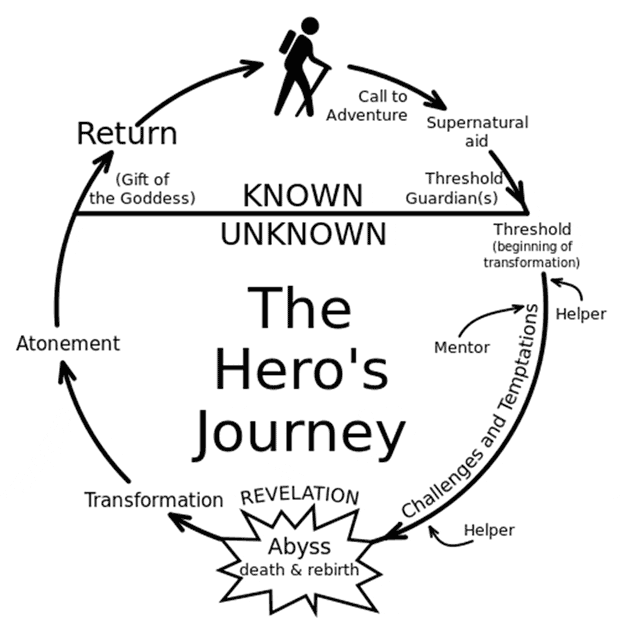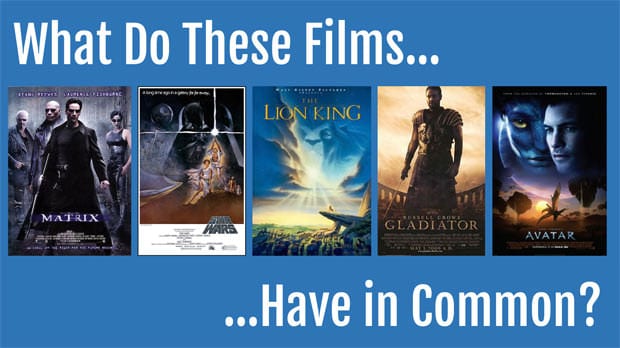An introduction to the "Hero's Journey" method of storytelling
Your product or services will likely solve a problem for your customers, or fulfil particular needs and wants. No matter how boring you view this product, it sits within a ‘story arc’ that can always be made interesting to consumers facing the challenges that it solves.
In Joseph Campbell’s book The Hero with a Thousand Faces, a basic pattern of storytelling is defined as a ‘monomyth’ or ‘hero’s journey’. This is a pattern that can be seen in a wide range of storytelling from around the world. Essentially, protagonists within a story go through a number of common stages, as below:

From Homer’s The Odyssey, to Medieval Romances and modern sci-fi adventures such as Star Wars Episode IV: A New Hope and Avatar, this story arc persists:
- The protagonist is inspired to go on an adventure.
- This adventure will present various challenges which will take the protagonist out of his known environment.
- The protagonist will meet a mentor or go through some specific training in order to fulfil his quest.
- There are a series of challenges of challenges and temptations for the protagonist to overcome.
- The protagonist overcomes these challenges, culminating in a critical final showdown.
- The protagonist completes the quest, and is subsequently rewarded for their efforts (in many stories, this is normally through the fulfilment of love, such as Odysseus returning home to win back his wife Penelope).

Using Star Wars as an example, the story arc is easily recognisable:
- Luke Skywalker is a young and romantic individual, living on a desolate planet with bigger dreams.
- He encounters two robot droids, who inform him that Princess Leia is in need of help escaping from the evil Empire.
- The message leads him to Obi Wan Kenobi, a Jedi Knight who begins to show Luke the ways of the force.
- Obi Wan takes Luke away from his home planet in order to save the Princess.
- With assistance from new characters, Luke rescues the Princess, but now faces the greater challenge of defeating the Empire through destroying the Death Star.
- After the fleet of rebel fighters suffer heavy losses, Luke manages to destroy the Deathstar with the assistance of one his new companions and his former mentor.
- Luke is rewarded at a medal ceremony.
We can use this kind of story arc in a content marketing strategy through switching the protagonist with the customer, and then offer mentorship through the content, and the promise of reward (or quest completion) from the product. For instance:
- Joe is a 28 year old marketing manager seemingly unaware of the potential of his company’s data.
- He reads a blog which tells him about the potential of having strong data management and reporting.
- He discovers that his company has little internal understanding of the potential value.
- He continues to read content from the blog, soon discovering that this company also offers a product that can solve his company’s data management issues.
- While the product might solve the issues, he encounters internal politics and IT issues that can prevent its deployment.
- Eventually Joe manages to get round the internal politics via a meeting with the IT Director. The product solution is deployed.
- The new data management leads to an increase in company revenue, and Joe is promoted.
While the second story is hardly going to make audiences as excited as one of the most successful films of all time, it can help you shape a relevant structure for you content marketing plan. For instance, from Joe’s potential ‘quest’, you could shape it as follows:
- Month One – Identify potential customer problems and create content to help them meet challenges.
- Month Two – Create content about the product, and the benefits it presents in meeting potential challenges.
- Month Three – Create content about meeting internal company conflict, and inform potential customers how to meet these specific challenges.
- Once these challenges are met (through purchase of the product) offer something as a reward to the customer. This could be exclusive content, lower rates on further purchases or non-financial rewards.
This story arc has a good understanding of the protagonist (who could be defined by your personas), their challenges and how you could solve these. It's a great place to start from!








